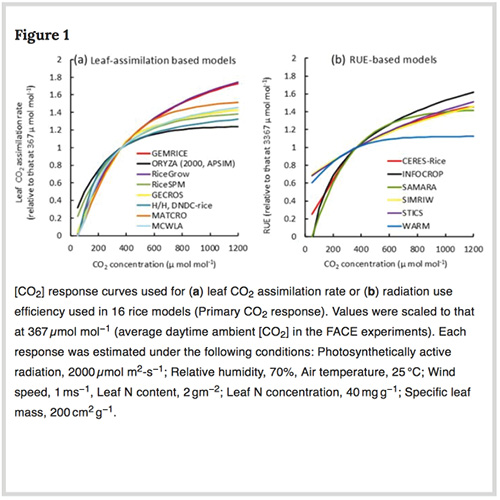Rice
Main Contact for Initiative
Toshihiro Hasegawa
Brief Description of Activity
The AgMIP rice team aims to intercompare and improve rice crop models to simulate impacts, adaptation and mitigation measures under climate change. Four major pillars to identify problems in the current modeling:
1) Abiotic stresses
2) Plant-soil interaction
3) Genetic traits
4) And biotic stresses

Current Research Focus
Improvements of temperature and nitrogen responses using SPAR chamber and multilocation field trials. Multi-model Ideo-typing and gene-based modeling for future genotypes.
Recent Noteworthy Finding
The multi-model ensemble reproduced the yield response to E-[CO2] well but the responses varied substantially among individual models. The variation was not associated with the types of photosynthesis models, but with different modeled responses in leaf area index.Theeffects of E-[CO2] on morphological development are key to reducing uncertainties.
Papers

Causes of variation among rice models in yield response to CO2 examined with Free-Air CO2 Enrichment and growth chamber experiments
Hasegawa Tetal (2017) Causes of variation among rice models in yield response to CO2examined with Free-Air CO2 Enrichment and growth chamber experiments. Scientific Reports, 7, 14858.
Prior Updates

The main contact for the rice pilot team is Tao Li, assisted by Xinyou Yin, Toshihiro Hasegawa, Yan Zhu, and Bas Bouman.
Collaborating scientists representing 13 rice models intercompared their models for response to CO2, temperature, rainfall, and other factors at four sentinel sites representing variation in rice productivity.
The rice team met Dec 3-5, 2012, at IRRI to discuss results and develop their publications. See the meeting agenda (AgMIP-Rice-Pilot-Workship-Program-2012) for activities and list of participants. As of February 10, the AgMIP-Rice team has a polished paper analyzing results. The AgMIP-Rice team planned to intercompare the rice models against growth and data observed in the FACE CO2 experiments in Japan and China, and then to intercompare rice models against data observed in elevated temperature studies conducted in sunlight, controlled environment chambers.
